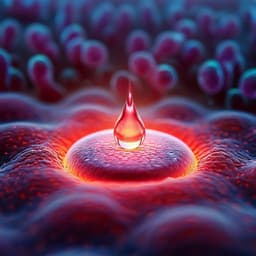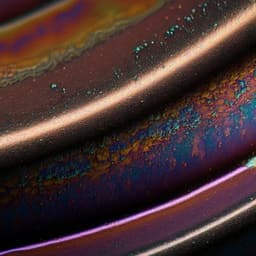
Engineering and Technology
A biocompatible electrolyte enables highly reversible Zn anode for zinc ion battery
G. Li, Z. Zhao, et al.
This groundbreaking study reveals a biocompatible hyaluronic acid-based hydrogel electrolyte that enhances the performance of zinc ion batteries, showing remarkable anti-corrosion properties and long-term stability, potentially revolutionizing biocompatible energy applications. The research was conducted by Guanjie Li, Zihan Zhao, Shilin Zhang, Liang Sun, Mingnan Li, Jodie A. Yuwono, Jianfeng Mao, Junnan Hao, Jitraporn (Pimm) Vongsvivut, Lidan Xing, Chun-Xia Zhao, and Zaiping Guo.
~3 min • Beginner • English
Introduction
The paper addresses the need for safe, soft, and biocompatible power sources for wearable and implantable devices. Conventional batteries are rigid and may pose safety risks due to toxic organics and leakage. Aqueous zinc metal batteries (AZMBs) are attractive because Zn is affordable, non-toxic, and has a favorable redox potential and high capacity. However, Zn anodes in liquid aqueous electrolytes suffer from dendrite growth, hydrogen evolution, and corrosion, leading to poor cycling stability. Hydrogels are promising due to flexibility and hydrogen-bond interactions that can suppress water-related side reactions, but existing hydrogel electrolytes often show inadequate ionic conductivity and limited control over Zn deposition, restricting high areal capacity and deep depth of discharge. The study proposes a hyaluronic acid (HA)-based hydrogel electrolyte to mitigate water reactivity, suppress corrosion, and regulate Zn nucleation/growth while maintaining high ionic transport and biocompatibility.
Literature Review
Prior strategies to stabilize Zn anodes include aqueous/organic hybrid electrolytes, functional additives, and high-concentration electrolytes that alter Zn²⁺ solvation and improve reversibility, but many raise biosecurity concerns due to toxic components. Liquid electrolytes can leak and separators can detach under strain in flexible systems. Hydrogel electrolytes of biocompatible polymers can reduce parasitic water reactions via tailored hydrogen bonding; however, many reported hydrogels still struggle with regulating Zn deposition and achieving sufficient ionic conductivity, limiting long-term stability and deep discharge performance. The literature highlights the need for biocompatible, non-toxic, mechanically robust gel electrolytes that both suppress water reactivity and control Zn nucleation/growth while enabling high-rate, long-life operation.
Methodology
Materials and electrolyte preparation: 2 M ZnSO₄ aqueous solution served as the liquid electrolyte. HA gel electrolytes were prepared by mechanically mixing 6, 15, or 30 wt% HA with 2 M ZnSO₄ at 40 °C overnight, yielding water contents of about 52.5, 47.5, and 39 wt% respectively. The 6 wt% HA composition was optimized for the balance of ionic conductivity and mechanical strength. HA forms gels via strong hydrogen bonding with water and is applicable to various Zn salts (e.g., ZnSO₄, ZnCl₂, Zn triflate).
Electrodes: LiMn₂O₄ (LMO) cathodes were made by blending LMO:Super P:PTFE at 6:2:2, cast on Ti mesh (coin/pouch) or carbon cloth (flexible). For Zn–I₂ cells, the catholyte was 0.05 M I₂ and 1 M LiI in water; the host was 75 wt% Ketjen black and 25 wt% PTFE on carbon cloth. Areal loadings: LMO ~11–12 mg cm⁻²; I₂ cathode 2.0–2.5 mg cm⁻². Zn foils (typically 100 µm; 16 µm for low N/P and DoD tests) were polished before use.
Cell assembly and testing: CR2032 coin cells used glass fiber separators. Symmetric Zn//Zn and asymmetric Zn//Cu cells were tested for long-term cycling, rate response, and Coulombic efficiency (CE). Intermittent galvanostatic charge/discharge (1 mA cm⁻², 1 mAh cm⁻², 50 h on/50 h rest) simulated practical corrosion. Zn//LMO full cells were cycled between 1.4–2.1 V at 1–3 C; Zn//I₂ between 0.5–1.6 V at high rates (up to 50 C). Pouch and flexible pouch cells were assembled for practical demonstrations.
Physicochemical and mechanical characterization: Ionic conductivity was measured (liquid by a conductivity meter; gel via EIS on Ti//Ti with calibrated cell constant). Mechanical properties (tensile elongation, compressive strength) were measured with a universal tester. FTIR (ATR mode) and Raman probed hydrogen bonding and coordination; pH was measured for corrosion-related analyses.
Electrochemistry and corrosion analyses: Electrochemical stability windows (ESW) were measured by LSV using Pt working electrode and Ag/AgCl reference to resolve HER/OER onsets. Tafel tests assessed corrosion current. Immersion experiments, XRD, and SEM examined corrosion products (e.g., ZHS) after soaking. EIS of Zn//Zn tracked interfacial resistance evolution.
Zn nucleation/growth studies: Cyclic voltammetry on Zn//Cu assessed nucleation overpotential. Chronoamperometry probed growth modes (2D vs 3D). SEM cross-sections and confocal laser microscopy quantified morphology, thickness, and roughness (Sa) of plated Zn under controlled capacities.
In situ spectroscopy and interfacial measurements: In situ synchrotron ATR-FTIR on Zn//stainless steel captured dynamic changes in OH and SO₄²⁻ bands during plating/stripping. Electric double layer capacitance (CEDL) on Zn was measured to infer ion distributions. Zn²⁺ transference number was measured via Bruce–Vincent method under small polarization. Desolvation activation energy (Ea) was obtained by temperature-dependent impedance and Arrhenius fitting.
Computations: Molecular dynamics (MD, GAFF2) evaluated hydrogen bonding among HA, H₂O, and Zn²⁺/SO₄²⁻, solvation structure, and coordination numbers; radial distribution functions quantified average coordination. Density functional theory (VASP, PBE with D3) computed binding and Gibbs free energies for candidate Zn²⁺ solvation clusters, including Zn(HA)(H₂O)₄ and ZnSO₄(HA)(H₂O)₄.
Biocompatibility: In vitro cytocompatibility was evaluated using WST-1 assays on human epidermal keratinocytes (HEKn) and RAW 264.7 macrophages after 24–48 h incubation with media containing HA gel electrolyte extracts at defined concentrations, with statistical analysis of viability relative to controls.
Key Findings
- HA gel electrolyte forms via strong hydrogen bonding between HA and water; gelation extends to multiple Zn salts. Ionic conductivity remains high (47.7 mS cm⁻¹ gel vs 57.0 mS cm⁻¹ liquid).
- Mechanical properties: elongation-at-break ≈220%; compressive strength ≈0.18 MPa; stretchable to 200% without failure. Reducing water content increases strength with slight conductivity loss.
- Hydrogen-bonding analyses: FTIR/Raman and MD show increased strong H-bonds in gel (87.2% vs 81.5% in liquid); HA–H₂O interactions convert H₂O–H₂O bonds to HA–H₂O. MD: one HA monomer forms ~16.5 H-bonds vs 1.53 for H₂O; DFT shows stronger HA–H₂O binding than H₂O–H₂O.
- Electrochemical stability window: On Pt, HER onset shifts more negative (−0.52 vs −0.36 V vs Ag/AgCl) and OER slightly more positive (~1.39 vs 1.36 V), indicating suppressed water splitting.
- Corrosion suppression: pH increases from 4.25 to 5.05 with HA; 1 wt% HA in water is neutral (pH 6.93). Tafel icorr: 0.297 mA cm⁻² (gel) vs 1.632 mA cm⁻² (liquid). Corrosion rates: 0.0068 mg h⁻¹ (gel) vs 0.0363 mg h⁻¹ (liquid). Immersion tests show minimal ZHS by-products in gel; severe ZHS formation and large interfacial resistances in liquid (Rct up to 7740 Ω after 7 days). Symmetric cells under intermittent cycling last >1200 h with gel vs 216 h with liquid.
- Zn nucleation/growth regulation: Higher nucleation overpotential in gel (smaller nucleus radius) yields fine, uniform deposits. Chronoamperometry shows immediate 3D diffusion with steady current in gel vs prolonged 2D diffusion in liquid. For 10 mAh cm⁻² deposition, Zn layer is thinner (24 μm gel vs 32 μm liquid) and smoother (Sa 1.10 μm gel vs 2.67 μm liquid). HA’s polyanionic skeleton provides a persistent electrostatic shielding effect, homogenizing current distribution.
- Solvation and transport: MD shows reduced average coordination number of H₂O around Zn²⁺ (4.49 gel vs 5.02 liquid); DFT indicates Zn(HA)(H₂O)₄ is thermodynamically favorable vs Zn(H₂O)₆²⁺ and disfavors SO₄²⁻ coordination. EDL capacitance increases (111→177 μF cm⁻²) indicating thinner EDL and enriched Zn²⁺ at the interface with reduced SO₄²⁻. Zn²⁺ transference number: 0.73 (gel) vs 0.24 (liquid). Desolvation activation energy: 42.4 kJ mol⁻¹ (gel) vs 61.4 kJ mol⁻¹ (liquid). In situ ATR-FTIR shows faster expulsion (blueshift/intensity reduction) of H₂O and SO₄²⁻ during plating in gel, confirming rapid desolvation.
- Long-term Zn anode performance: Symmetric Zn//Zn (1 mA cm⁻², 1 mAh cm⁻²) operates stably for 5500 h with ~50 mV overpotential; liquid fails at ~482 h. At 5 mA cm⁻²/5 mAh cm⁻², gel supports ~1200 h cycling. Under medium and high DoDZn: 650 h at 33% and 250 h at 80% in gel. Zn//Cu CE averages 99.71% over 2000 cycles (1 mA cm⁻², 1 mAh cm⁻²), with cumulative capacity ~3 Ah cm⁻².
- Corrosion/by-product suppression during cycling: In liquid, white ZnS and ZHS form due to HER-induced OH⁻ increase; gel suppresses HER and corrosion, yielding smooth, compact deposits (16 μm after 100 cycles vs 54 μm in liquid).
- Full-cell and device demonstrations: Zn//LMO hybrid AZMBs show 82% capacity retention after 1000 cycles at 3 C (coin cells). Pouch cells (single-layer) deliver 93.9 mAh g⁻¹ at 1 C with 78% retention after 400 cycles and average CE 99.83%. Flexible pouch cells give 111.0 mAh g⁻¹ at 1 C; capacity retention under deformation: 101% (90° bend), 98% (180° bend), 94% (fold), 90% (roll), powering a hygrometer.
- Zn–I₂ cells: 194.3 mAh g⁻¹ at 10 C; capacity retention 92% after 10,000 cycles and 73% after 20,000 cycles; 150.0 mAh g⁻¹ at 50 C. Liquid electrolyte counterpart lasts ~2000 cycles due to dendrites.
- Biocompatibility: HA gel electrolyte shows negligible cytotoxicity to HEKn and RAW 264.7 cells over 24–48 h (no statistically significant viability reduction).
Discussion
The HA-based hydrogel electrolyte directly addresses the central challenges of aqueous Zn anodes: water reactivity, parasitic hydrogen evolution, corrosion, and uncontrolled dendritic deposition. Strong HA–H₂O hydrogen bonding reduces the activity of water, expanding the electrochemical stability window and suppressing HER/OER. The polyanionic HA backbone competes for coordination with H₂O and repels SO₄²⁻, restructuring the Zn²⁺ solvation shell toward HA-containing species with fewer water molecules and weaker anion coordination. This lowers desolvation energy and increases the Zn²⁺ transference number, delivering more uniform Zn²⁺ flux to the interface. Concurrently, the persistent electrostatic shielding effect of HA homogenizes local current density and reduces the surface energy at protrusions, guiding uniform nucleation and horizontal growth of compact Zn deposits. These coordinated effects mitigate by-product formation (ZHS, ZnS), reduce interfacial impedance growth, and prevent dendrite-induced short circuits, resulting in ultralong symmetric-cell lifetimes, high Coulombic efficiency, and robust performance at high utilization (DoDZn). When translated to full cells, the electrolyte delivers durable, high-rate cycling in Zn//LMO and Zn–I₂ chemistries and functions reliably in flexible pouch configurations. The demonstrated in vitro biocompatibility further supports suitability for bio-interfaced, wearable, and implantable devices.
Conclusion
The study introduces a biocompatible hyaluronic acid hydrogel electrolyte that effectively suppresses water reactivity and corrosion, remodels Zn²⁺ solvation, accelerates desolvation, and homogenizes interfacial ion flux, thereby stabilizing Zn nucleation and growth. This yields record-level Zn anode reversibility (average CE 99.71%, symmetric-cell life up to 5500 h, stable cycling at high DoDZn) and robust full-cell performance (Zn//LMO coin and pouch cells, flexible devices) as well as exceptional longevity and rate capability in Zn–I₂ batteries. The work establishes a practical, safe gel chemistry for wearable and implantable energy systems.
Potential future directions include: optimizing HA content and water fraction to further balance conductivity and mechanics; exploring other benign biopolymers or functionalized HA to fine-tune solvation and interfacial effects; extending to diverse cathode chemistries and high-loading electrodes; assessing long-term in vivo compatibility and device encapsulation strategies; and scaling flexible architectures for integrated bioelectronics.
Limitations
- The HA gel shows slightly reduced ionic conductivity relative to liquid electrolyte and a modest increase in initial polarization, indicating a trade-off between mechanical gelation and transport.
- Biocompatibility was assessed via in vitro cell viability (HEKn, RAW 264.7); in vivo safety, immune response, and long-term implantation behavior were not evaluated.
- Performance optimization focused on specific HA contents (e.g., 6 wt%); broader compositional spaces (water fraction, salt concentration, alternative salts) were not exhaustively studied.
- While multiple zinc salts can form gels with HA, most electrochemical tests were conducted with 2 M ZnSO₄; generality across salts and extreme operating conditions (temperature, humidity) needs further validation.
Related Publications
Explore these studies to deepen your understanding of the subject.







